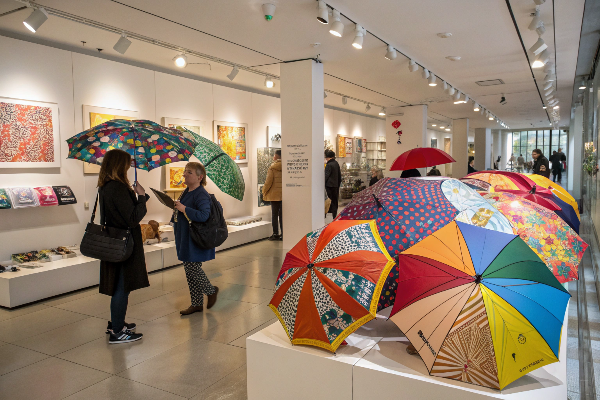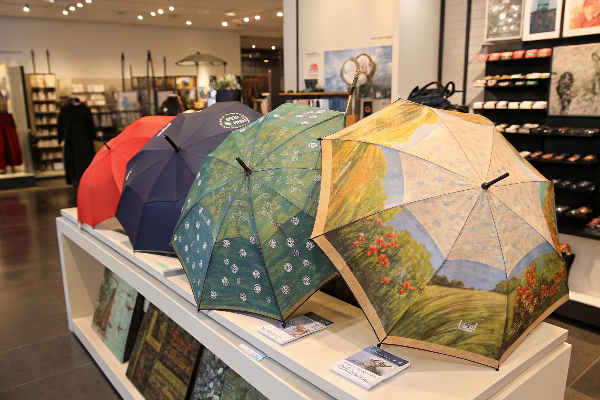Why Umbrellas Are the Perfect Museum Souvenir for Art Lovers

When I walk into a museum gift shop, I often see rows of umbrellas, and I always wonder why they stand out so much.
Umbrellas are the perfect museum souvenir because they combine practical daily use with artistic expression. They are both functional and meaningful, carrying cultural designs that remind visitors of their museum experience.
They might look simple at first glance, but the truth is, umbrellas carry more stories than most souvenirs you find in a shop. Let’s break it down.
What Makes Umbrellas a Popular Museum Gift?
When I first noticed umbrellas in museum shops, I thought they were just a clever way to make money.
Umbrellas are popular museum gifts because they blend usefulness with artistic themes, offering both practicality and cultural meaning. Their large surface allows for creative museum-inspired designs that visitors proudly carry.

Practical and Long-Lasting
Umbrellas are not fragile trinkets. They shield us from rain and sun, which makes them a practical item tourists actually use instead of leaving in a drawer.
Art Meets Function
Museums take advantage of the wide fabric space. They print masterpieces, patterns, or architectural motifs on them. Visitors don’t just get an umbrella—they get a portable artwork.
Table: Why Umbrellas Beat Other Souvenirs
| Souvenir | Practicality | Artistic Value | Longevity |
|---|---|---|---|
| Umbrellas | High | High | Long-term |
| Keychains | Low | Low | Long-term |
| T-shirts | Medium | Medium | Medium |
| Posters | Low | High | Medium |
Emotional Value
Some museums design umbrellas after famous collections. Imagine walking around with Van Gogh’s “Starry Night” or Monet’s water lilies above your head. That umbrella becomes more than just a shield—it becomes an emotional connection to art.
How Do Art Umbrellas Connect With Visitors?
I once walked under a sky full of suspended umbrellas in a museum courtyard. I felt like I stepped into another world.
Art umbrellas connect with visitors by transforming everyday objects into immersive experiences. They invite people to interact, share space, and form emotional bonds with both the art and the museum itself.
Interactive and Playful
When museums display painted umbrellas outside, they don’t just decorate space. They invite people to sit, take photos, and feel part of the art.
Table: Connections Created by Art Umbrellas
| Type of Connection | Example Activity | Impact on Visitors |
|---|---|---|
| Emotional | Sitting under painted umbrellas | Sense of belonging |
| Social | Group photos under installations | Community feeling |
| Cultural | Traditional umbrella-making workshops | Learning heritage |
More Than Decoration
Public art projects like the “Umbrella Sky Project” show how simple umbrellas can brighten neighborhoods. They symbolize joy, openness, and solidarity. People walk under them and suddenly feel part of something larger.
Hands-On Engagement
Some museums even offer umbrella-painting sessions. Visitors don’t just buy—they create. This hands-on process helps people appreciate both the craft and cultural heritage of umbrellas.
In the end, these colorful canopies turn into bridges that connect humans, cultures, and emotions.
Are Umbrella Souvenirs Practical for Tourists?
I once bought a museum umbrella abroad, and it saved me from a sudden downpour the next day.
Umbrella souvenirs are practical for tourists because they provide real protection from rain and sun while being compact, portable, and infused with cultural meaning that lasts beyond the trip.
Everyday Use
Tourists need items that work during travel, not just after. Compact folding umbrellas fit neatly in backpacks and luggage, making them practical.
Table: Tourist Considerations When Buying Umbrellas
| Factor | Why It Matters | Example |
|---|---|---|
| Size & Weight | Easy to carry in luggage | Compact folding umbrellas |
| Quality | Longer-lasting souvenir | UV-protected, sturdy umbrellas |
| Cultural Tie | Memorable and meaningful | Chinese paper umbrellas |
Cultural Symbolism
Some umbrellas are decorative, like Japanese wagasa or Chinese paper umbrellas. While fragile, they carry stories of tradition and heritage, making them special keepsakes.
Sustainability
Modern eco-friendly designs made from recycled materials also give tourists a reason to buy. These choices align with a growing demand for meaningful, sustainable souvenirs.
So yes, umbrellas are more than practical—they are thoughtful travel companions that blend culture with utility.
Why Do Museums Sell More Umbrellas Than Other Items?
Whenever I check museum shop sales reports, umbrellas often top the charts.
Museums sell more umbrellas because they are practical, artistically designed, and appeal to a wide range of visitors. They merge functionality with cultural storytelling, making them irresistible souvenirs.
Practicality Meets Storytelling
People justify buying umbrellas because they know they will use them. The added artistic twist seals the deal.
Artistic Showcase
Unlike mugs or magnets, umbrellas provide a canvas for big, bold designs. Museums use this to showcase famous artworks.
Table: Why Umbrellas Outsell Other Gifts
| Reason | Explanation |
|---|---|
| Everyday Utility | Visitors can use them daily |
| Strong Artistic Surface | Large canopy for prints and patterns |
| Broad Appeal | Works for locals, tourists, all age groups |
| Symbolism | Connects with culture and history |
Curated and Unique
Museum shops rarely sell generic items. Umbrellas feel curated, sometimes even exclusive, like limited editions tied to an exhibition. That sense of uniqueness drives more sales.
How Do Art Umbrellas Preserve Cultural Value?
I once saw a traditional oil-paper umbrella in a museum in China, and it felt like holding a piece of living history.
Art umbrellas preserve cultural value by carrying traditional designs, craftsmanship, and symbolic meanings that connect present generations with ancestral heritage and community identity.

Historical Symbolism
- In ancient China, umbrellas symbolized royalty and divine power.
- In weddings, red umbrellas were believed to ward off evil and bring prosperity.
- In African and Indian rituals, umbrellas still signal status and celebration.
Craftsmanship as Heritage
The handmade process—bamboo frames, oil paper, hand-painted motifs—keeps centuries-old techniques alive. This craftsmanship reflects both artistry and identity.
Table: Examples of Cultural Umbrella Traditions
| Region | Umbrella Type | Symbolic Meaning |
|---|---|---|
| China | Red oil-paper umbrella | Luck and protection |
| Japan | Wagasa | Harmony with nature |
| India | Ceremonial parasols | Royalty and celebration |
| Africa | Ritual umbrellas | Community pride |
Preservation Through Tourism
By selling or displaying these umbrellas, museums help artisans pass down knowledge. Tourists not only buy, but they also learn about heritage. This supports both cultural pride and economic survival for local communities.
Art umbrellas therefore serve as living cultural vessels. They protect us from rain, but more importantly, they protect our history.
Conclusion
Umbrellas are not just souvenirs—they are art, culture, and practicality woven into one timeless object.


